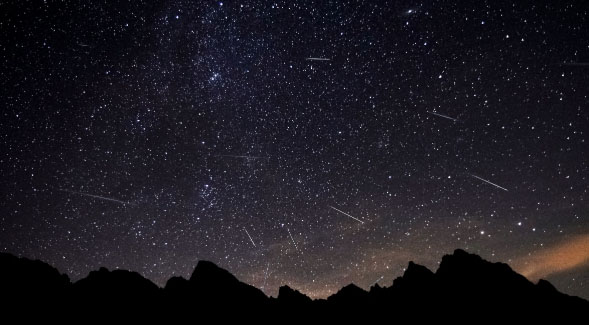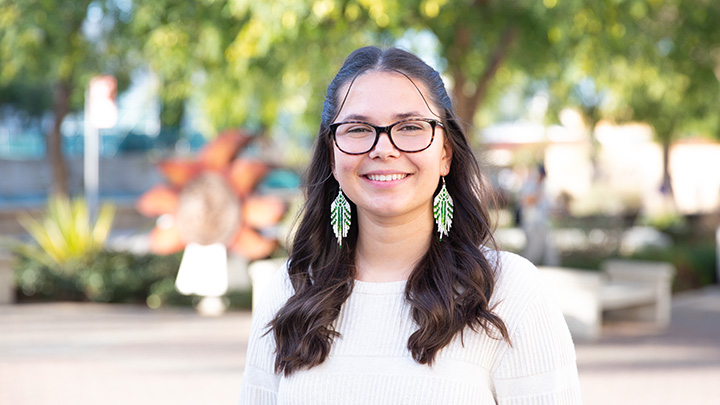Perseid Meteor Shower Q&A with SDSU professor of Astronomy Douglas Leonard
The annual light show will peak across the Northern Hemisphere in mid-August.

The Perseid meteor shower peaks every year in mid-August, and is visible across the Northern Hemisphere. This year, it will reach its peak on August 11 and 12, during the full moon.
SDSU NewsCenter’s Susanne Clara Bard caught up with San Diego State University astronomy professor Doug Leonard to get the lowdown on this year’s light show and where to find the best viewing locations in San Diego and Imperial Counties.
What are meteor showers?
The Earth orbits the sun once per year, and is traveling at about 67,000 miles per hour in its orbit. Other, much smaller objects also orbit the sun with similar speed, most notably, comets: objects made of dust and ice that also orbit the sun. Their elliptical orbits bring them very close to — and then very far away from — the sun over dozens or hundreds of years. When comets get close to the sun, they heat up, producing a trail of debris: generally dust-to-pebble-sized chunks of the comet itself called meteoroids. Then, later, when the Earth passes through this debris trail, all of that junk streams into our atmosphere at high speed (typically 25,000 to 160,000 mph). That kind of speed causes a great deal of friction between the meteoroid and the air, which heats it to several thousand degrees. The extreme heat then causes the outer layers of these tiny bits of dust and rock — made up primarily of silicon, nickel, and iron — to vaporize. It also heats the air immediately surrounding the meteoroid. The extreme heat causes the "glow" that we call a meteor or shooting star; most of it comes from atmospheric gasses that surround the meteoroid, but a small amount comes from the vaporized material of the meteoroid itself.
Why do meteor showers happen at the same time every year?
The debris left by the responsible comet is always at the same location in Earth's orbit around the sun, so it gets plowed into by Earth at the same time every year! There are historical records of shooting stars going all the way back to several hundred years B.C.E. However, the modern understanding that meteor showers are predictable, repeatable events that occur at the same time each year was not really developed until the 1800s, and the firm connection between comets and meteor showers was not fully established until the 1870s.
What are the Perseids?
The Perseid meteor shower, i.e. “The Perseids” is probably the best-known and most widely observed meteor shower visible in the Northern Hemisphere. Comet 109P/Swift-Tuttle produces the Perseid meteor shower. The comet was independently discovered by two astronomers in 1862, although Chinese records indicate that it had been seen as early as 322 B.C.E. The Perseids are named after the constellation Perseus, which the meteors appear to "radiate" from.
Meteors from this shower can be seen as early as mid-July and as late as the last week of August, but peak viewing occurs sometime between August 9 and August 14: up to 100 meteors per hour can be seen in good conditions from a dark location. The Perseids are one of the most prolific showers, generating among the highest reliable rates of shooting stars per hour. The shower is also particularly well-placed in the sky for those of us located in the Northern Hemisphere, and occurs at a nice time of year for outdoor star-gazing. This year, the peak is expected to occur between August 11 and 12, with the best viewing in the pre-dawn hours of Friday, August 12. Another idea is to look again in the late evening around August 21, when the moon will be below the horizon and the Perseids should still be producing shooting stars.
What other meteor showers are coming up this year that people shouldn’t miss?
The other reliable really great meteor shower is the Geminids, which peak around December 14. The Geminids are similar to the Perseids in producing many bright shooting stars per hour near the peak. An asteroid known as 3200 Phaethon is responsible for the Geminids meteor shower. The radiant is in the constellation of Gemini, but shooting stars can be seen all over the sky.
What are some great places to watch the Perseids and other meteor showers?
Look for any place that is dark and has a nice, clear view of the sky, unobstructed by buildings or trees. You can see shooting stars at any time of night, although the early morning hours are typically best. For the Perseids, the pre-dawn hours are best since Perseus will be highest in the sky, but you can see meteors from the shower well before the "radiant" rises! So, even if you can't stay up or travel, heading out in your backyard at 10 p.m. and looking up for a half hour will probably be rewarded!
On the SDSU Campus:
- ENS 700 Recreational Field (adjacent to Viejas Arena and the Music Building)
In San Diego County:
- Mount Laguna in the Cleveland National Forest
- Lake Cuyamaca, near Julian
- Anza-Borrego Desert State Park, near Borrego Springs
- Torrey Pines State Beach, La Jolla (parking lot closes at sunset, but parking along North Torrey Pines Road is allowed until 11 p.m).
In Imperial County:
- Salton Sea State Recreational Area, on the eastern shore of the Salton Sea



